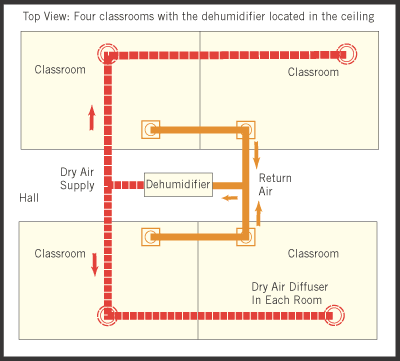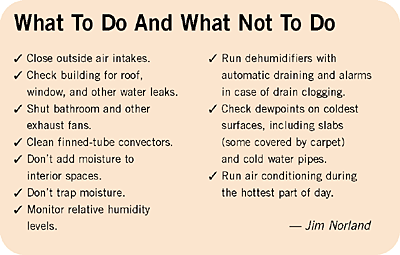
The risk is even greater this year in many parts of the United States, where wet weather has heightened the potential for damage caused by high humidity levels in the schools.
“Many schools in Louisiana shut off the HVAC system to save money during the unoccupied summer months,” noted Todd Page, who is with the Louisiana Office of Public Health, Section of Environmental Epidemiology and Toxicology, in a posting to an Indoor Air Quality forum last May.
As a result, he continued, teachers sometimes find mold in their classrooms when they return in August to start preparing for the fall term. Page solicited advice on recommendations his office might make to school boards and principals.
Even without this summer’s moisture, the problem exists, and not just in the South. Experts in moisture control and the impact of too much moisture on mold growth see the issue as virtually universal. They say that aggressive control of moisture is essential.
Dehumidification is perhaps the single most effective tool. Strict management of the structure, maintenance procedures, mechanical systems (even bathroom exhaust fans), and moisture contributors such as open fresh air intakes are also vital.
Most guidelines for moisture control peak at 60 percent relative humidity (rh), but 50 percent or lower is preferred, as in the Texas Department of Health Voluntary Guidelines for all government buildings. “We’ve heard many stories about schools where teachers have returned after a summer and found mold on everything,” said Kay Soper, environmental specialist with the department’s Indoor Air Quality branch.
Run The A/C — Sometimes
Keeping a vacant school’s air conditioning system on may take some water out of the air, but often not enough, and usually at a high energy cost. Still, schools might save the cost of a mold remediation program by running their HVAC system intermittently, enough to keep the moisture levels down.Some schools benefit from bringing in dehumidifiers to pull the moisture out, Soper stated.
“Dehumidification is the best thing in the world,” said Gene Tanner, building official with the Flagler County, Fla., School District, the state’s fastest growing district. But, he told The News, “School buildings can get excessively hot in the summertime.”
He recommends running school HVAC systems for two or three hours during the hottest part of the day and shutting them off completely after evening cooling begins. “Make sure you turn them off early enough so the building can heat back up,” he said. The building temperature will rise and cause relative humidity to drop, he says.
Enabling air conditioners on a 24-hour basis at a 72 degrees F setpoint won’t work; Tanner has found that humidity will creep back up and level out at about 96 percent. “Unloaded air conditioners do not dry.” On the other hand, shutting down the HVAC system completely is “bad, bad, bad.”
No one procedure will work for every system, he emphasized. He urges accurate monitoring of humidity levels using data loggers, and shutting down outside air intakes since there’s no requirement for ventilation in unoccupied buildings.

Moisture Contributors
Many schools have their carpets shampooed right after closing for the summer. This can add to the humidity problem, Tanner and Soper noted. To prevent excess moisture from this process, Flagler County schools use a triple-extraction process — first with normal extraction, then with a bonnet, and finally toweling the floor with terry cloth pads to extract 90 percent of the moisture.“My pet peeve in schools is the unit ventilator in classic classroom construction,” said Steve Temes, industrial hygienist with AirWays Environmental Services, Red Bank, N.J. The thin-tube convectors are often concealed behind the bookshelves, where they collect dust and mold spores, he pointed out. It’s a mold-growth haven.
Temes has performed hundreds of building investigations on problems that stem from failure to prevent or manage moisture/water intrusion problems. He said it’s important to remove or clean any dust reservoirs before and after any vacation shutdown. “It all boils down to removing any food source that the mold spores could use if sufficient moisture is available.”
How can moisture be controlled in schools without air conditioning? In one system in the Northeast, he recommended dehumidifiers in each classroom. He urged the installation of units with gravity drains into classroom sinks, but school officials felt that since janitors were there every day, they could empty the reservoirs.
“There’s a lot of room for human error in that situation,” Temes stated. “If someone isn’t there to empty it, it can shut itself off and then you have no dehumidification. If a person puts the reservoir in incorrectly, the shutoff may not work and water will overflow onto floors or carpets. Humans are going to splash around, do something wrong, or forget the system on weekends.”
Temes’ advice is to make sure surface water drains away from the building, and check flat roofs, rain gutters, and downspouts for proper drainage. Other potential trouble points are plumbing systems and leaking windows. “Nothing will help you when you’re continuously wicking moisture in through exterior walls, foundation slabs, or the ceiling,” he observed.

Troublesome Libraries
School libraries or media centers have a particularly high potential for mold development if humidity is not controlled. Tanner emphasizes that dehumidification units should be running all the time in such places.Mani Skaria, Ph.D., a plant pathologist and mycologist at Texas A&M University-Kingsville Citrus Center, Weslaco, Texas, agrees. “Mold growth on library materials is difficult to control and also expensive,” he said. “Therefore, running the HVAC system throughout in libraries is essential.”
Temes said an “economy” approach to school moisture problems during shutdown periods might be to concentrate all classroom books in one room, such as the library, and concentrate dehumidification there. “Make it an oasis of dry air, and allow the humidity to build up in other areas where there’s not a lot of dust and paper.”
Humidity Goals
Reducing humidity to 50 percent during overnight periods can inhibit mold growth, said Ken Gehring, president and general manager of Therma-Stor LLC, Madison, Wis. His company is drying some 500 classrooms that way, even during in-school months.“The critical issue is to avoid extended hours of 60 percent or greater relative humidity,” he responded to Page, who sought guidelines for school systems in Louisiana. Mold needs sustained high humidity to start growing, Gehring pointed out.
“Many schools are using small commercial dehumidifiers,” he continued. “No cooling is required and the dehumidifiers add a small amount of heat, which helps avoid condensation. One hundred pints per day (ppd) of capacity controls 4,000 square feet of floor space, with an operating cost of about 15 cents/square foot/month.”
Therma-Stor makes dehumidifiers ranging from that 100-ppd size on up to larger, often ducted units that can handle three or four classrooms.
Additional Factors To Consider
Moisture control isn’t just a function of relative humidity, but also the temperatures of surfaces in the room. “If you have a below-grade room and a cold slab, what might be 60 percent rh in room air, near the cold surface that might be 80 or 90 percent rh and even achieve dewpoint and become liquid water,” Temes pointed out.Ground temperatures are warmer in southern climates than in the North, and that makes a difference too, commented Brendan Reid, a building scientist with Comfort Institute, Ottawa.
“The whole problem we’re trying to avoid is creating an environment conducive to mold growth,” said Reid. Turning off cooling during the summer break may not be a problem (especially in cooler climates), but turning off dehumidification is, he said.
“The challenge, then, is to keep the space dry so mold doesn’t have a hospitable environment without having to run the whole central cooling,” he observed.
“Stand-alone DX dehumidification systems can do that.” He’s frequently recommended Therma-Stor units rather than “consumer-grade” dehumidifiers.
“At the kind of temperatures we’re talking about,” Reid told The News, “using a whole bunch of residential-grade dehumidifiers is not a bad strategy, but they do have an energy penalty and don’t last as long.” Reid hasn’t worked with school systems directly, but has 25 years of experience with the Canadian building science industry.
Whatever equipment is used to dehumidify, it’s essential that condensate drains in a foolproof manner, he said. “Ideally, provide the units with a secondary drain in case of a problem with the primary drain. On top of that, I’d put a wet switch on the secondary drain pan that would set off an alarm to notify school maintenance people that there’s a problem.”
Other potential condensing surfaces in the classroom or school include uninsulated cold-water pipes when water is running through them, Temes said. “Fifty percent rh in the room could be too high if you have a really cold surface where condensation can foster microbial growth.”
Publication date: 08/11/2003

Report Abusive Comment